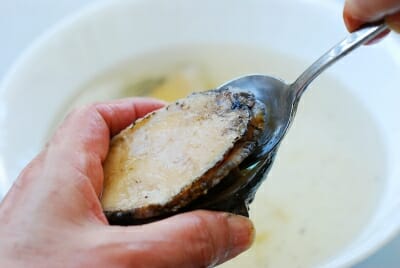Jeonbok juk is a Korean porridge made with abalone and rice. It’s delicious and nourishing!
On Jeju Island (Jeju-do, 제주도), where my parents are from, fresh abalone (jeonbok, 전복) are abundant. Porridge made with abalone (jeonbokjuk, 전복죽) is one of the most iconic dishes on the island. When we visited last fall, my cousin, who’s a Jeju native and always happy to show us around, took us to a place famous for its abalone porridge. It was deliciously briny, with a distinct greenish hue and chunky abalone pieces.
As my parents would say, that’s how jeonbokjuk should be! So, here’s abalone porridge recipe Jeju-style! Easy to digest and nourishing, this porridge is especially comforting when one feels under the weather.
Abalone are highly prized shellfish. For centuries, female divers in Jeju-do collected abalone and other seafood for a living by diving deep into the ocean floor for several hours a day. They are known as haenyeo (해녀) in Korea, meaning sea women. The number of haenyeo has sharply declined in modern days as other job options have become more available. As such, today’s high demand for abalone in Korea is being mostly met by farmed abalone.
Finding abalones fresh from the ocean is almost impossible where I live. Some Korean markets carry fresh live abalones in their fish tanks. You can also get frozen abalones, still in their shells. Use fresh ones if available and affordable.
How to make abalone porridge
The Jeju-style jeonbokjuk is made simply with rice and abalone. It captures all the flavors the abalone have to give by also using the internal organs (viscera), hence the greenish hue. The dark green sac of guts may not look all that appetizing, but it really enriches the porridge. The color of the porridge depends on the number and the size of the abalone used.
If you don’t care for the guts in your porridge, you can leave them out. You can also add chopped vegetables if you’d like.
More porridge recipes
Turkey porridge (with Thanksgiving leftovers)
Dakjuk (Chicken porridge)
Hobak juk (pumpkin porridge)
Patjuk (sweet red bean porridge)
For more Korean cooking inspirations, follow along on YouTube, Pinterest, Twitter, Facebook, and Instagram.

Jeonbokjuk (Abalone Porridge)
Print RecipeIngredients
- 1 cup short grain rice measuring cup not the cup that came with your rice cooker
- 2 or 3 medium size 3.5 to 4 ounces each abalone (use 3 or 4 if smaller in size)
- 2 tablespoons sesame oil
- Salt or soup soy sauce to taste
- 1/2 teaspoon sesame seeds - optional garnish
Instructions
- Soak the rice for about an hour and drain.
- Scrub off the dark edges of the abalone with a kitchen brush or toothbrush. Remove the abalone from the shell by working a spoon or small spatula around the muscle attached to the shell.
- Carefully cut off the viscera (guts) with a knife, or pull it off by hand.
- Cut off the tough pointed end. Slice the abalone meat into the desired thickness. Chop up the guts into small pieces, and scrape it off with a knife in to a small bowl.
- Add the rice and the guts to a medium size pot. Mix them well, breaking up any lumps of guts. Add the sesame oil and stir until the rice starts to turn translucent over medium heat, about 5 minutes. Throw in the abalone pieces and stir for a couple more minutes.
- Add 6 cups of water and bring it to a boil over medium high heat.
- Reduce the heat to medium, and continue to boil, stirring occasionally (more frequently as the stock is reduced so the rice doesn’t stick to the bottom of the pot), for about 25 minutes.
- At this point you can adjust the consistency of the porridge to your taste by adding more water, up to 1 cup. If adding more water, cook for a few more minutes, stirring well. Further reduce the heat to medium low heat as necessary. Add salt or soup soy sauce to taste right before serving.

































